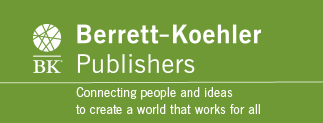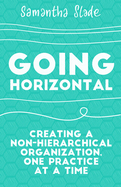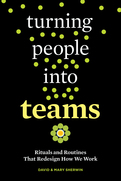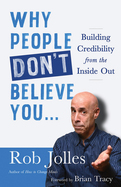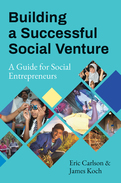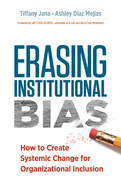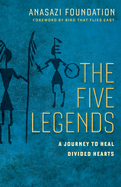Search Results: ""
Results 1003-1008 of 1358
Going Horizontal
2018
Hierarchy in organizations is obsolete. There is a better way: one that increases the engagement of employees and managers alike, reduces micromanaging and other limiting approaches, and promotes organizational and individual success.
In this book, self-management expert Samantha Slade presents seven concrete practices to help your organization flatten its existing hierarchy and develop a horizontal organization. The result will be enhanced creativity, greater growth, and a increased employee retention and productivity—and a better bottom line.
These days, more than ever, successful organizations must respond quickly and nimbly to change—they need every employee's best thinking. A horizontal organization creates an environment of true collaboration, respect, and openness. It allows everyone more freedom to express unconventional ideas or to work through issues that are getting in the way of organizational goals. And it's a more human way to organize—after all, we function perfectly well in our day-to day lives without someone telling us what to do.
But when an organization decides to go horizontal, it can be overwhelming for both managers and employees. Slade offers a practical, proven, incremental method to help organizations of all kinds and sizes ease in to a non-hierarchical model. She includes techniques for using your organization's purpose to stay focused and aligned, developing shared decision-making, creating a mutual feedback culture, nurturing autonomy, holding co-managed meetings, and maintaining an environment of collective learning.
Going Horizontal will help organizations become more adaptive, collaborative and innovative, which is vital in today's highly competitive and constantly-evolving world.
In this book, self-management expert Samantha Slade presents seven concrete practices to help your organization flatten its existing hierarchy and develop a horizontal organization. The result will be enhanced creativity, greater growth, and a increased employee retention and productivity—and a better bottom line.
These days, more than ever, successful organizations must respond quickly and nimbly to change—they need every employee's best thinking. A horizontal organization creates an environment of true collaboration, respect, and openness. It allows everyone more freedom to express unconventional ideas or to work through issues that are getting in the way of organizational goals. And it's a more human way to organize—after all, we function perfectly well in our day-to day lives without someone telling us what to do.
But when an organization decides to go horizontal, it can be overwhelming for both managers and employees. Slade offers a practical, proven, incremental method to help organizations of all kinds and sizes ease in to a non-hierarchical model. She includes techniques for using your organization's purpose to stay focused and aligned, developing shared decision-making, creating a mutual feedback culture, nurturing autonomy, holding co-managed meetings, and maintaining an environment of collective learning.
Going Horizontal will help organizations become more adaptive, collaborative and innovative, which is vital in today's highly competitive and constantly-evolving world.
"Project and team leaders, do yourself a favor and make this book required reading by each member of your team!" —HR Professionals Magazine
Collaborative strategies work when they're designed by teams—where each person is heard, valued, and held accountable. This book is a practical guide for project team leaders and individual contributors who want their teams to play by a better set of rules.
Today's teams want more alignment among their members, better decision-making processes, and a greater sense of ownership over their work. This can be easy, even fun, if you have the right rituals.
Rituals are group activities during which people go through a series of behaviors in a specific order. They give teams the ability to create a collective point of view and reshape the processes that affect their day-to-day work. In Turning People into Teams, you'll find dozens of practical rituals for finding a common purpose at the beginning of a project, getting unstuck when you hit bottlenecks or brick walls, and wrapping things up at the end and moving on to new teams.
Customizable for any industry, work situation, or organizational philosophy, these rituals have been used internationally by many for-profit and not-for-profit organizations. By implementing just a few of these rituals, a team can capture the strengths of each individual for incredible results, making choices together that matter.
Collaborative strategies work when they're designed by teams—where each person is heard, valued, and held accountable. This book is a practical guide for project team leaders and individual contributors who want their teams to play by a better set of rules.
Today's teams want more alignment among their members, better decision-making processes, and a greater sense of ownership over their work. This can be easy, even fun, if you have the right rituals.
Rituals are group activities during which people go through a series of behaviors in a specific order. They give teams the ability to create a collective point of view and reshape the processes that affect their day-to-day work. In Turning People into Teams, you'll find dozens of practical rituals for finding a common purpose at the beginning of a project, getting unstuck when you hit bottlenecks or brick walls, and wrapping things up at the end and moving on to new teams.
Customizable for any industry, work situation, or organizational philosophy, these rituals have been used internationally by many for-profit and not-for-profit organizations. By implementing just a few of these rituals, a team can capture the strengths of each individual for incredible results, making choices together that matter.
For some, projecting confidence and credibility is second nature. For others, it seems like a foreign language they'll never learn – until now. Rob Jolles delivers down-to-earth solutions for anyone looking to enhance the most basic need of all; to be believed. He leverages his over 30 years of experience to equip readers with empowering and practical tools for achieving business and social success.
Jolles argues that credibility is as much about attitude as it is about aptitude. So-called “soft skills” like pitch, pace, and tone of voice, are actually some of the most crucial factors in determining how people perceive us. As he puts it, “it's not the words, it's the tune” that really makes us memorable and credible.
This book is about finding the necessary magic to help others believe you. It requires an unshakable belief in yourself, so Jolles starts there. With that as a solid foundation, you can move on to the specific tactics and practices that will make you credible and convincing. But these can be tough to practice in the face of the inevitable setbacks we all face, so he also offers advice on maintaining courage and confidence when doubt naturally creeps in. And he concludes with a discussion of sustaining your newfound credibility for the long haul.
There isn't a soul on earth who hasn't questioned themselves at some point. And most of us are just one or two brutal rejections away from questioning all that we are. Why People Don't Believe You helps readers cultivate a robust mental framework and a set of what Jolles calls “performance skills” to tackle these doubts. You are good enough –and after reading this stirring book, you'll be ready to make the world believe that as well.
Jolles argues that credibility is as much about attitude as it is about aptitude. So-called “soft skills” like pitch, pace, and tone of voice, are actually some of the most crucial factors in determining how people perceive us. As he puts it, “it's not the words, it's the tune” that really makes us memorable and credible.
This book is about finding the necessary magic to help others believe you. It requires an unshakable belief in yourself, so Jolles starts there. With that as a solid foundation, you can move on to the specific tactics and practices that will make you credible and convincing. But these can be tough to practice in the face of the inevitable setbacks we all face, so he also offers advice on maintaining courage and confidence when doubt naturally creeps in. And he concludes with a discussion of sustaining your newfound credibility for the long haul.
There isn't a soul on earth who hasn't questioned themselves at some point. And most of us are just one or two brutal rejections away from questioning all that we are. Why People Don't Believe You helps readers cultivate a robust mental framework and a set of what Jolles calls “performance skills” to tackle these doubts. You are good enough –and after reading this stirring book, you'll be ready to make the world believe that as well.
This is the first book on creating and running a social enterprise to combine theoretical discussions with current cases from around the world, filling a huge gap in the literature. It serves as an eminently practical blueprint for those who wish to build, sustain, and grow social ventures.
Building a Successful Social Venture draws on Eric Carlson's and James Koch's pioneering work with the Global Social Benefit Institute, cofounded by Koch at Santa Clara University's Miller Center for Social Entrepreneurship. Since 2003, over 200 Silicon Valley executives have mentored more than 800 aspiring social entrepreneurs at the GSBI. It is this unparalleled real-world foundation that truly sets the book apart. Early versions of the book were used in both undergraduate and MBA classes.
Part 1 of the book describes the assumptions that the GSBI model is based on: a bottom-up approach to social change, a focus on base-of-the-pyramid markets, and a specific approach to business planning developed by the GSBI. Part 2 presents the seven elements of the GSBI business planning process, and Part 3 lays out the keys to executing it. The book includes “Social Venture Snapshots” illustrating how different organizations have realized elements of the plan, as well as a wealth of checklists and exercises.
Social ventures hold enormous promise to solve some of the world's most intractable problems. This book offers a tested framework for students, social entrepreneurs, and field researchers who wish to learn more about the application of business principles and theories of change for advancing social progress and creating a more just world.
Building a Successful Social Venture draws on Eric Carlson's and James Koch's pioneering work with the Global Social Benefit Institute, cofounded by Koch at Santa Clara University's Miller Center for Social Entrepreneurship. Since 2003, over 200 Silicon Valley executives have mentored more than 800 aspiring social entrepreneurs at the GSBI. It is this unparalleled real-world foundation that truly sets the book apart. Early versions of the book were used in both undergraduate and MBA classes.
Part 1 of the book describes the assumptions that the GSBI model is based on: a bottom-up approach to social change, a focus on base-of-the-pyramid markets, and a specific approach to business planning developed by the GSBI. Part 2 presents the seven elements of the GSBI business planning process, and Part 3 lays out the keys to executing it. The book includes “Social Venture Snapshots” illustrating how different organizations have realized elements of the plan, as well as a wealth of checklists and exercises.
Social ventures hold enormous promise to solve some of the world's most intractable problems. This book offers a tested framework for students, social entrepreneurs, and field researchers who wish to learn more about the application of business principles and theories of change for advancing social progress and creating a more just world.
All humans have bias, and as a result, so do the institutions we build. Internationally sought after diversity consultant Tiffany Jana offers concrete ways for anyone to work against institutional bias no matter what their position is in an organization.
Building upon the revelatory power of her book Overcoming Bias, which addressed managing individual and interpersonal bias, Erasing Institutional Bias scales up the framework to impact systemic change in organizations. Jana and coauthor Ashley Diaz Mejias bring together in-depth research on how biases become embedded into workplace cultures with practical and engaging tools that will mobilize readers toward action. They confront specific topics such as racism, sexism, hiring and advancement bias and retribution bias, meaning when organizations develop a culture of aggression, and offer solutions for identifying and controlling them.
This book urges readers to ask questions such as, “Are we attempting to create systems in which all people can thrive? What kind of world and what kind of workplaces are we cultivating?” These questions, the authors say, must first be answered by ourselves, recognizing our own role in perpetuating harmful biases that come to define institutions.
In a world divided, Erasing Institutional Bias is designed to raise awareness about imbalances and help us hold ourselves accountable for creating a world that works for everyone. Each of us can evaluate our own current role in perpetuating systemic bias and define our new role in breaking it down. Jana and Mejias inspire and equip us so that we can all affect organizational change, together.
Building upon the revelatory power of her book Overcoming Bias, which addressed managing individual and interpersonal bias, Erasing Institutional Bias scales up the framework to impact systemic change in organizations. Jana and coauthor Ashley Diaz Mejias bring together in-depth research on how biases become embedded into workplace cultures with practical and engaging tools that will mobilize readers toward action. They confront specific topics such as racism, sexism, hiring and advancement bias and retribution bias, meaning when organizations develop a culture of aggression, and offer solutions for identifying and controlling them.
This book urges readers to ask questions such as, “Are we attempting to create systems in which all people can thrive? What kind of world and what kind of workplaces are we cultivating?” These questions, the authors say, must first be answered by ourselves, recognizing our own role in perpetuating harmful biases that come to define institutions.
In a world divided, Erasing Institutional Bias is designed to raise awareness about imbalances and help us hold ourselves accountable for creating a world that works for everyone. Each of us can evaluate our own current role in perpetuating systemic bias and define our new role in breaking it down. Jana and Mejias inspire and equip us so that we can all affect organizational change, together.
The Five Legends
2019
Drawing on 30 years of helping families in-crisis, this profound fable by the Anasazi Foundation illustrates the anguish of conflict and shows how we can end war within ourselves, within families, and even between nations.
The Five Legends tells the story of two estranged brothers, leaders of their people, who find themselves on an unexpected journey. Struggling against each other, they stumble and fall into a great and terrible canyon. Trapped, the two brothers are rescued by an old man—“the last of a people”—who offers to guide them out of the canyon if they agree to learn the five legends of peace. The brothers agree and begin a journey that may not only save themselves, but also their people.
The brothers learn that to heal any conflict we must first look within ourselves. As this fable beautifully puts it, “War does not begin or end with armies and leaders. In truth, war begins and ends within each of us—within our hearts. When we choose to war with others, we turn our hearts away from them and blind ourselves to their light. …To have a heart at war is to invite war into your life.” The path to peace begins when we stop thinking about “me” and start thinking about “WE.”
This poetic and moving allegory is written for all ages. Its message is both timeless and desperately needed for our own time
The Five Legends tells the story of two estranged brothers, leaders of their people, who find themselves on an unexpected journey. Struggling against each other, they stumble and fall into a great and terrible canyon. Trapped, the two brothers are rescued by an old man—“the last of a people”—who offers to guide them out of the canyon if they agree to learn the five legends of peace. The brothers agree and begin a journey that may not only save themselves, but also their people.
The brothers learn that to heal any conflict we must first look within ourselves. As this fable beautifully puts it, “War does not begin or end with armies and leaders. In truth, war begins and ends within each of us—within our hearts. When we choose to war with others, we turn our hearts away from them and blind ourselves to their light. …To have a heart at war is to invite war into your life.” The path to peace begins when we stop thinking about “me” and start thinking about “WE.”
This poetic and moving allegory is written for all ages. Its message is both timeless and desperately needed for our own time
